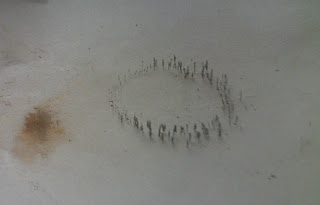During week one K. finished her pillow and began crocheting another chain. I was going to teach her the slip stitch, but she just wants to make chains, which is really better because she does need to get better at making her chains all the same size. She is improving!
During week two we did two pages in her piano book.
We went to The Skirball Museum this week and saw a portrait and a seascape and answered the questions in our book,
Let's Visit the Art Museum. I have picked up some books from the library which we will use either instead of or with visits to a museum.
This week I needed to make a couple sock monkeys. I had enough socks to make three, so K. is making her own. I have all the machine sewing done and she has done some of the hand sewing.
Here is her completed sock monkey. She did all the hand sewing, except for the mouth. We sewed it on the wrong side the first time, so she asked me to sew it on the right side for her.
We spent this week on art. We worked in her book,
Let's Visit the Art Museum. I picked up these books at the library:
- Mousterpiece by Jane Breskin Zalben -- a fun book about art
- Katie Meets the Impressionists by James Mayhew -- gives the opportunity of seeing famous paintings and learning a bit about artists in a fun way. This is part of a series of books.
- My Art Book by DK Publishing -- this is a book of art projects inspired by masterpieces. This is a book I want to do a lot from. This week we worked on decorating a rock. The projects all look fun and the instructions are very well written.
- Discover Great Paintings* by Lucy Micklethwait -- this book has reproductions of famous paintings along with questions and observations about each one. There is also information about the artist and the painting.
- Come Look With Me: World of Play* by Gladys S. Blizzard -- this book has reproductions of paintings, a few questions about each one and then a few paragraphs about the painting and the artist.
* We only looked at one or two pictures in these books.


















